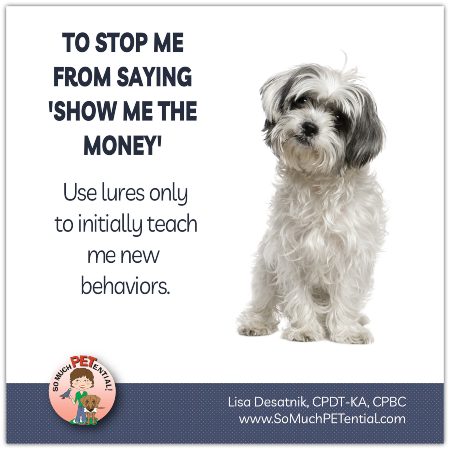I see it happen all of the time. When I ask people to show me how they ask their dog to sit, they they pull out a treat, hold it in front of their dog’s face and tell their dog to sit. AND their dog sits. This is called luring, one strategy used in dog training to teach behaviors. While luring can be helpful in teaching new behaviors, there are problems with using lures too much that I’ll talk about more in this post.
Luring As A Dog Training Strategy
 Remember, it is the reinforcement history that ultimately is what builds strong, fluent behaviors; however, in order to have a reinforcement history, you’ve got to get the behavior to happen one way or another. There are different strategies for that. Among them are shaping (think about the hot and cold game you played as a child), modeling (social learning -by watching others do the behavior), capturing (seeing the behavior naturally happen) and luring.
Remember, it is the reinforcement history that ultimately is what builds strong, fluent behaviors; however, in order to have a reinforcement history, you’ve got to get the behavior to happen one way or another. There are different strategies for that. Among them are shaping (think about the hot and cold game you played as a child), modeling (social learning -by watching others do the behavior), capturing (seeing the behavior naturally happen) and luring.
I sometimes begin teaching new behaviors by holding a food lure just in front of the dog’s nose and moving my hand in the direction that I want the dog to move. Once the dog is in that position, I then give a marker such as YES or GOOD or a click, that is immediately followed by giving the dog a treat (either in position or away from the dog).
When I use a food lure this way, an immediate goal is to stop using the lure as quickly as possible. Generally, after I have lured the dog into position 3 to 5 repetitions and the dog is easily moving, I then begin doing the same hand movement WITHOUT holding food in it. Once the dog does the target behavior, I then give the marker and present a piece of food that had been held either behind my back, in a treat pouch, or on a counter. This begins the process of weaning the dog off of the lure.
If I will be adding a verbal cue to the target behavior, I may do any one of the following depending on that particular learner. I may say the word SIT ‘just before’ I make my hand gesture and then begin to make smaller and smaller hand gestures. I may also be able to change to capturing if my student begins naturally offering the target behavior and then say the word SIT just before I can tell the dog is going to SIT.
Only when the dog has had solid practice of sitting just after I way SIT, will I try it cold. When the dog is not focusing on the behavior, I’ll say SIT, then mark/reinforce for the behavior.
Some additional ways to reduce the lure dependency include taking the food off of you. You can have it placed around your house. When you ask your dog to do the behavior, after you give your marker, you can then move to the food to present it. You can also use everyday moments to reinforce behavior.
After you say, SIT and your dog sits, then:
Attach a leash
Start a game of play
Open a door
Tell your dog to say hi to someone
Beware Of Another Caution
Your dog is always watching your movement. If you are someone who walks over to the refrigerator, cupboard or bag of treats on the mantle before asking your dog to do something, that action can become an environmental cue to your dog that means, ‘time to pay attention!’. In other words, ‘no need to pay attention to mom and dad UNTIL they move toward something I want’.
Be conscious of teaching your pet the contingency that WHEN a target behavior is performed, THEN a valued consequence will follow.







